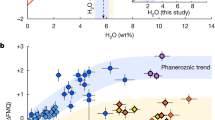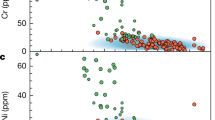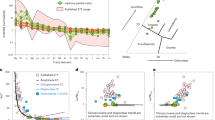Abstract
The geodynamic setting leading to the formation of Earth’s first continents remains debated. Zircons preserved in Archaean granitoids record evidence of a relatively oxidizing and wet magmatic source. Subduction-related mechanisms for the formation of Archaean granitoids have been invoked to explain these signatures, suggesting an early initiation of subduction on Earth between 4.0 and 3.6 billion years ago, in the Eoarchaean era. Here I use forward petrological modelling and Monte Carlo randomization models to show that relatively oxidizing and wet magmas resembling Archaean granitoids worldwide can occur from melts derived from the partial melting of an overthickened mafic crust in a non-subduction scenario. The formation of oxidizing and wet magmatic signatures is therefore not diagnostic of continental crust generation by subduction or of subduction initiation in the Eoarchaean. Instead, the apparent observed increase in oxygen fugacity and water contents during the Eoarchaean may indicate magmatic thickening and melting of overthickened crust with time, suggesting that this process may have contributed to the development of Earth’s first continents.
This is a preview of subscription content, access via your institution
Access options
Access Nature and 54 other Nature Portfolio journals
Get Nature+, our best-value online-access subscription
27,99 € / 30 days
cancel any time
Subscribe to this journal
Receive 12 print issues and online access
269,00 € per year
only 22,42 € per issue
Buy this article
- Purchase on SpringerLink
- Instant access to full article PDF
Prices may be subject to local taxes which are calculated during checkout




Similar content being viewed by others
Data availability
All data are available via Zenodo at https://doi.org/10.5281/zenodo.11506583 (ref. 39). In addition, all data necessary for evaluating the findings of this study are available in this article and its Supplementary Information. Source data are provided with this paper.
References
Ge, R. F., Wilde, S. A., Zhu, W. B. & Wang, X. L. Earth’s early continental crust formed from wet and oxidizing arc magmas. Nature 623, 334–339 (2023).
Palin, R. M. et al. Secular change and the onset of plate tectonics on Earth. Earth Sci. Rev. 207, 103172 (2020).
Palin, R. M., White, R. W. & Green, E. C. Partial melting of metabasic rocks and the generation of tonalitic–trondhjemitic–granodioritic (TTG) crust in the Archaean: constraints from phase equilibrium modelling. Precambrian Res. 287, 73–90 (2016).
Rapp, R. P., Shimizu, N. & Norman, M. D. Growth of early continental crust by partial melting of eclogite. Nature 425, 605–609 (2003).
Arndt, N. How did the continental crust form: no basalt, no water, no granite. Precambrian Res. 397, 107196 (2023).
Condie, K. C. & Kröner, A. in When Did Plate Tectonics Begin on Planet Earth (eds Condie, K. C. & Pease, V.) 281–294 (Geological Society of America, 2008).
Moyen, J. F. & Martin, H. Forty years of TTG research. Lithos 148, 312–336 (2012).
Johnson, T. E., Brown, M., Gardiner, N. J., Kirkland, C. L. & Smithies, R. H. Earth’s first stable continents did not form by subduction. Nature 543, 239–242 (2017).
Hartnady, M. I. et al. Fluid processes in the early Earth and the growth of continents. Earth Planet. Sci. Lett. 594, 117695 (2022).
Webb, A. A. G., Müller, T., Zuo, J., Haproff, P. J. & Ramírez-Salazar, A. A non-plate tectonic model for the Eoarchean Isua supracrustal belt. Lithosphere 12, 166–179 (2020).
Condie, K. C. Archean Greenstone Belts (Elsevier, 1981).
Martin, H., Moyen, J.-F., Guitreau, M., Blichert-Toft, J. & Le Pennec, J.-L. Why Archaean TTG cannot be generated by MORB melting in subduction zones. Lithos 198, 1–13 (2014).
Kendrick, J. & Yakymchuk, C. Garnet fractionation, progressive melt loss and bulk composition variations in anatectic metabasites: complications for interpreting the geodynamic significance of TTGs. Geosci. Front. 11, 745–763 (2020).
Hernández-Montenegro, J. D., Palin, R. M., Zuluaga, C. A. & Hernández-Uribe, D. Archean continental crust formed by magma hybridization and voluminous partial melting. Sci. Rep. 11, 5263 (2021).
Smithies, R. H. et al. Oxygen isotopes trace the origins of Earth’s earliest continental crust. Nature 592, 70–75 (2021).
Johnson, T. E. et al. Giant impacts and the origin and evolution of continents. Nature 608, 330–335 (2022).
Kamber, B. S. Archean mafic–ultramafic volcanic landmasses and their effect on ocean–atmosphere chemistry. Chem. Geol. 274, 19–28 (2010).
Bindeman, I. N. et al. Rapid emergence of subaerial landmasses and onset of a modern hydrologic cycle 2.5 billion years ago. Nature 557, 545–548 (2018).
Tamblyn, R. et al. Hydrated komatiites as a source of water for TTG formation in the Archean. Earth Planet. Sci. Lett. 603, 117982 (2023).
Brown, M. & Johnson, T. Secular change in metamorphism and the onset of global plate tectonics. Am. Mineral. 103, 181–196 (2018).
Palin, R. M., Weller, O. M., Waters, D. J. & Dyck, B. Quantifying geological uncertainty in metamorphic phase equilibria modelling; a Monte Carlo assessment and implications for tectonic interpretations. Geosci. Front. 7, 591–607 (2016).
Tang, M., Erdman, M., Eldridge, G. & Lee, C. T. A. The redox ‘filter’ beneath magmatic orogens and the formation of continental crust. Sci. Adv. 4, eaar4444 (2018).
Lee, C. T. A. & Tang, M. How to make porphyry copper deposits. Earth Planet. Sci. Lett. 529, 115868 (2020).
Holder, R. M., Viete, D. R., Brown, M. & Johnson, T. E. Metamorphism and the evolution of plate tectonics. Nature 572, 378–381 (2019).
de Capitani, C. & Brown, T. H. The computation of chemical equilibrium in complex systems containing non-ideal solutions. Geochim. Cosmochim. Acta 51, 2639–2652 (1987).
de Capitani, C. & Petrakakis, K. The computation of equilibrium assemblage diagrams with Theriak/Domino software. Am. Mineral. 95, 1006–1016 (2010).
Holland, T. & Powell, R. An improved and extended internally consistent thermodynamic dataset for phases of petrological interest, involving a new equation of state for solids. J. Metamorph. Geol. 29, 333–383 (2011).
Holland, T. J., Green, E. C. & Powell, R. Melting of peridotites through to granites: a simple thermodynamic model in the system KNCFMASHTOCr. J. Petrol. 59, 881–900 (2018).
Green, E. et al. Activity–composition relations for the calculation of partial melting equilibria in metabasic rocks. J. Metamorph. Geol. 34, 845–869 (2016).
White, R., Powell, R., Holland, T., Johnson, T. & Green, E. New mineral activity–composition relations for thermodynamic calculations in metapelitic systems. J. Metamorph. Geol. 32, 261–286 (2014).
Holland, T. J. B., Green, E. C. R. & Powell, R. A thermodynamic model for feldspars in KAlSi3O8–NaAlSi3O8–CaAl2Si2O8 for mineral equilibrium calculations. J. Metamorph. Geol. 40, 587–600 (2022).
White, R., Powell, R., Holland, T. & Worley, B. The effect of TiO2 and Fe2O3 on metapelitic assemblages at greenschist and amphibolite facies conditions: mineral equilibria calculations in the system K2O–FeO–MgO–Al2O3–SiO2–H2O–TiO2–Fe2O3. J. Metamorph. Geol. 18, 497–511 (2000).
Kress, V. C. & Carmichael, I. S. The compressibility of silicate liquids containing Fe2O3 and the effect of composition, temperature, oxygen fugacity and pressure on their redox states. Contrib. Mineral. Petrol. 108, 82–92 (1991).
Frost, B. R. in Oxide Minerals (ed. Lindsley, D. H.) 1–10 (De Gruyter, 1991).
Cottrell, E. & Kelley, K. A. The oxidation state of Fe in MORB glasses and the oxygen fugacity of the upper mantle. Earth Planet. Sci. Lett. 305, 270–282 (2011).
Berry, A. J., Stewart, G. A., O’Neill, H. S. C., Mallmann, G. & Mosselmans, J. F. W. A re-assessment of the oxidation state of iron in MORB glasses. Earth Planet. Sci. Lett. 483, 114–123 (2018).
Zhang, H. L., Cottrell, E., Solheid, P. A., Kelley, K. A. & Hirschmann, M. M. Determination of Fe3+/ΣFe of XANES basaltic glass standards by Mössbauer spectroscopy and its application to the oxidation state of iron in MORB. Chem. Geol. 479, 166–175 (2018).
Aulbach, S. & Stagno, V. Evidence for a reducing Archean ambient mantle and its effects on the carbon cycle. Geology 44, 751–754 (2016).
Hernández-Uribe, D. Supplementary dataset for manuscript "Generation of Archaean oxidizing and wet magmas from mafic crustal overthickening". Zenodo https://doi.org/10.5281/zenodo.11506583 (2024).
Acknowledgements
J. D. Hernández-Montenegro, R. M. Palin and R. M. Holder are thanked for the fruitful discussion on the topic. D. Tinkham is thanked for continuous help with Theriak-Domino.
Author information
Authors and Affiliations
Corresponding author
Ethics declarations
Competing interests
The author declares no competing interests.
Peer review
Peer review information
Nature Geoscience thanks Elizabeth Bell, Rongfeng Ge and the other, anonymous, reviewer(s) for their contribution to the peer review of this work. Primary Handling Editor: Alison Hunt, in collaboration with the Nature Geoscience team.
Additional information
Publisher’s note Springer Nature remains neutral with regard to jurisdictional claims in published maps and institutional affiliations.
Supplementary information
Supplementary Tables
Supplementary Tables 1 and 2.
Rights and permissions
Springer Nature or its licensor (e.g. a society or other partner) holds exclusive rights to this article under a publishing agreement with the author(s) or other rightsholder(s); author self-archiving of the accepted manuscript version of this article is solely governed by the terms of such publishing agreement and applicable law.
About this article
Cite this article
Hernández-Uribe, D. Generation of Archaean oxidizing and wet magmas from mafic crustal overthickening. Nat. Geosci. 17, 809–813 (2024). https://doi.org/10.1038/s41561-024-01489-z
Received:
Accepted:
Published:
Issue Date:
DOI: https://doi.org/10.1038/s41561-024-01489-z



